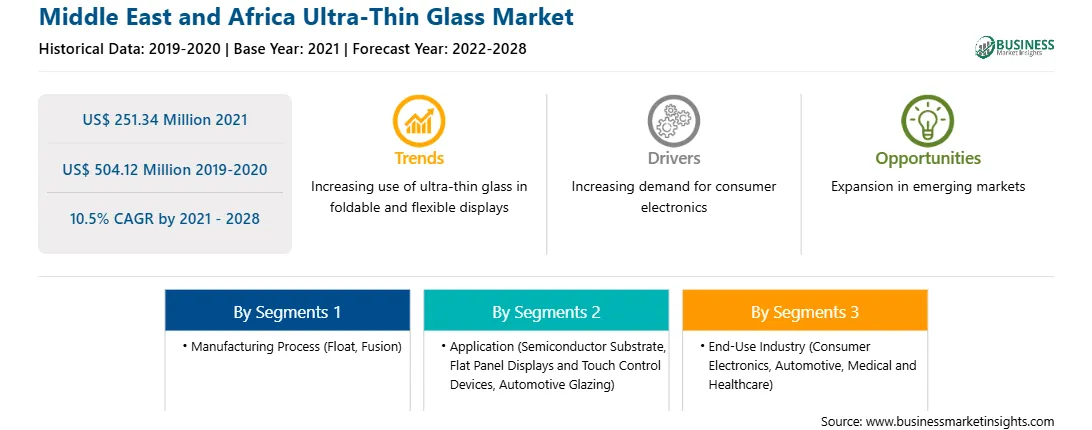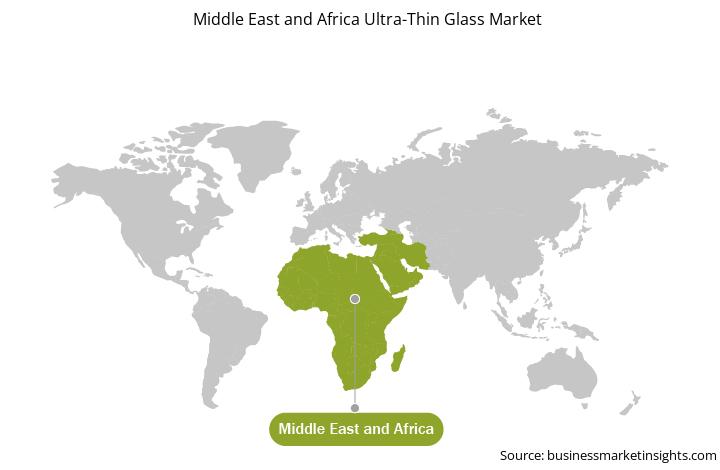中东和非洲超薄玻璃市场预测至 2028 年 - 按制造工艺(浮法和熔合)、应用(半导体基板、平板显示器和触摸控制设备、汽车玻璃等)划分的 COVID-19 影响和区域分析最终用途行业(消费电子、汽车、医疗保健等)
No. of Pages: 119 | Report Code: TIPRE00025831 | Category: Chemicals and Materials
No. of Pages: 119 | Report Code: TIPRE00025831 | Category: Chemicals and Materials
MEA超薄玻璃市场分为南非、沙特阿拉伯、阿联酋和其他国家MEA。该地区的经济大幅增长,导致人们生活方式的改变和消费者消费能力的增强。随着该地区人们生活方式的改善,该地区对消费电子产品的需求预计也会增加。智能手机、笔记本电脑、智能手表和其他此类设备在该地区年轻人中的日益普及预计将在预测期内支持超薄玻璃市场的增长。超薄玻璃在电子领域有着广泛的应用,因为它用于触摸和显示面板、电子和光学传感器、能量存储设备和半导体。预计该地区对 LCD、LED、OLED、智能手机、显示器和笔记本电脑等电子设备的需求在不久的将来将会增加,这将促进超薄玻璃的使用。
在MEA、南非和以色列的 COVID-19 确诊病例和死亡人数最多。据国际金融公司称,COVID-19 大流行对中东和非洲地区的经济造成了严重影响,因为它减少了石油生产、旅游业和汇款。该地区包括许多发展中经济体,这些经济体是超薄玻璃供应商的潜在市场。由于汽车等少数行业的增长受到负面影响,该流行病已显着减缓了该地区超薄玻璃市场的增长。
MEA 超薄玻璃市场预计将从 2017 年的 2.5134 亿美元增长2021年到2028年达到5.0412亿美元;预计2021年至2028年复合年增长率为10.5%。该地区的超薄玻璃市场也受到健身手环和智能手表等智能可穿戴设备需求不断增长的影响。这些智能可穿戴设备需要具有防刮、耐热、防水、耐候的轻质显示屏,并且具有更长的电池寿命。超薄玻璃减轻了设备的整体重量,使用起来非常方便。因此,该地区对智能可穿戴设备不断增长的需求预计将在预测期内推动超薄玻璃市场的增长。由于电子产品销量飙升以及消费者对电子产品的支出增加,预计中东和非洲地区将为超薄玻璃市场提供利润丰厚的机会。
MEA超薄玻璃市场细分为制造工艺、应用、最终用途行业和国家。根据制造工艺,MEA超薄玻璃市场分为浮法玻璃、熔融玻璃。 2020年,融合细分市场占据最大市场份额。根据应用,MEA超薄玻璃市场分为半导体基板、平板显示器和平板玻璃。触摸控制设备、汽车玻璃等。平板显示器领域在2020年占据最大的市场份额。根据最终用途,MEA超薄玻璃市场分为消费电子、汽车、医疗和医疗。医疗保健,其他。消费电子领域在 2020 年占据最大的市场份额。按国家划分,MEA 超薄玻璃市场分为沙特阿拉伯、南非和阿联酋,以及 MEA 的其他地区。中东和非洲其他地区在 2020 年占据了最大的市场份额。
一些主要的主要来源准备本中东和非洲超薄玻璃市场报告时参考的二手来源包括公司网站、年度报告、财务报告、国家政府文件和统计数据库等。报告中列出的主要公司有AGC Inc.;康宁公司;南玻集团有限公司;浮现玻璃;日本板硝子有限公司;肖特股份公司;及信义玻璃控股有限公司。
MEA 超薄玻璃市场 - 按最终用途行业划分
Strategic insights for Middle East and Africa Ultra-Thin Glass involve closely monitoring industry trends, consumer behaviours, and competitor actions to identify opportunities for growth. By leveraging data analytics, businesses can anticipate market shifts and make informed decisions that align with evolving customer needs. Understanding these dynamics helps companies adjust their strategies proactively, enhance customer engagement, and strengthen their competitive edge. Building strong relationships with stakeholders and staying agile in response to changes ensures long-term success in any market.

| Report Attribute | Details |
|---|---|
| Market size in 2021 | US$ 251.34 Million |
| Market Size by 2028 | US$ 504.12 Million |
| Global CAGR (2021 - 2028) | 10.5% |
| Historical Data | 2019-2020 |
| Forecast period | 2022-2028 |
| Segments Covered |
By 制造工艺
|
| Regions and Countries Covered | 中东和非洲
|
| Market leaders and key company profiles |
The regional scope of Middle East and Africa Ultra-Thin Glass refers to the geographical area in which a business operates and competes. Understanding regional nuances, such as local consumer preferences, economic conditions, and regulatory environments, is crucial for tailoring strategies to specific markets. Businesses can expand their reach by identifying underserved regions or adapting their offerings to meet regional demands. A clear regional focus allows for more effective resource allocation, targeted marketing, and better positioning against local competitors, ultimately driving growth in those specific areas.

The Middle East and Africa Ultra-Thin Glass Market is valued at US$ 251.34 Million in 2021, it is projected to reach US$ 504.12 Million by 2028.
As per our report Middle East and Africa Ultra-Thin Glass Market, the market size is valued at US$ 251.34 Million in 2021, projecting it to reach US$ 504.12 Million by 2028. This translates to a CAGR of approximately 10.5% during the forecast period.
The Middle East and Africa Ultra-Thin Glass Market report typically cover these key segments-
The historic period, base year, and forecast period can vary slightly depending on the specific market research report. However, for the Middle East and Africa Ultra-Thin Glass Market report:
The Middle East and Africa Ultra-Thin Glass Market is populated by several key players, each contributing to its growth and innovation. Some of the major players include:
The Middle East and Africa Ultra-Thin Glass Market report is valuable for diverse stakeholders, including:
Essentially, anyone involved in or considering involvement in the Middle East and Africa Ultra-Thin Glass Market value chain can benefit from the information contained in a comprehensive market report.